
Eucryphia is a small genus of trees and large shrubs native to the south temperate regions of South America and coastal eastern Australia, mainly Tasmania. Sometimes placed in a family of their own, the Eucryphiaceae, more recent classifications place them in the Cunoniaceae. There are seven species, two in South America and five in Australia, and several named hybrids.

Westringia is a genus of Australian shrubs. As with other members of the mint family their upper petal is divided into two lobes. There are four stamens - the upper two are fertile while the lower two are reduced to staminodes. The leaves are in whorls of 3 or 4.
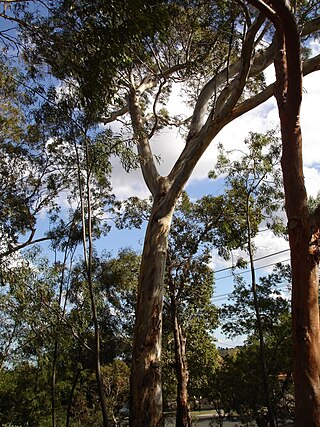
Eucalyptus leucoxylon, commonly known as yellow gum, blue gum or white ironbark, is a species of small to medium-sized tree that is endemic to south-eastern continental Australia. It has smooth yellowish bark with some rough bark near the base, lance-shaped or curved adult leaves, flower buds in groups of three and cylindrical, barrel-shaped or shortened spherical fruit. A widely cultivated species, it has white, red or pink flowers.

Bursaria spinosa is a small tree or shrub in the family Pittosporaceae. The species occurs mainly in the eastern and southern half of Australia and not in Western Australia or the Northern Territory. Reaching 10 m (35 ft) high, it bears fragrant white flowers at any time of year but particularly in summer. A common understorey shrub of eucalyptus woodland, it colonises disturbed areas and fallow farmland. It is an important food plant for several species of butterflies and moths, particularly those of the genus Paralucia, and native bees.
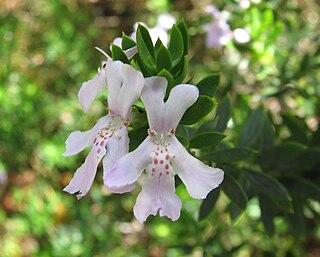
Westringia glabra, commonly known as violet westringia, is a flowering plant in the family Lamiaceae and is endemic to Australia. It is a small shrub with oval-shaped leaves and pinkish, mauve or purple flowers.
Westringia cremnophila, commonly known as Snowy River westringia, is a flowering plant in the family Lamiaceae, a rare shrub that is endemic to Victoria, Australia. It is a small shrub with leaves mostly in groups of three and white flowers.
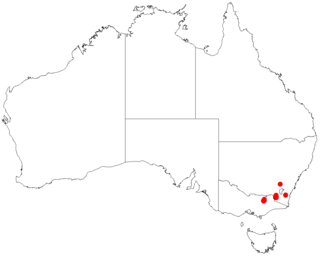
Prostanthera monticola, commonly known as Buffalo mint-bush, is a species of flowering plant in the family Lamiaceae and is endemic to higher areas of south-eastern Australia. It is a sprawling, open shrub with red, hairy branches, lance-shaped to narrow elliptic leaves and pale bluish-green to grey-green flowers with dark purple-blue veins.

Westringia eremicola, commonly known as slender westringia or slender western rosemary, is a flowering plant in the family Lamiaceae and is endemic to eastern Australia. It is a small shrub, with narrow leaves and pink, mauve to white flowers.

Patersonia sericea, commonly known as purple flag or silky purple-flag is a species of plant in the iris family Iridaceae and is endemic to eastern Australia. It is a densely-tufted perennial herb with linear, sword-shaped leaves, broadly egg-shaped, bluish-violet tepals and an oval capsule.
Barry John Conn, is an Australian botanist. He was awarded a Ph.D. from Adelaide University in 1982 for work on Prostanthera.

Westringia rigida is a shrub in the Lamiaceae family that is endemic to Australia. and
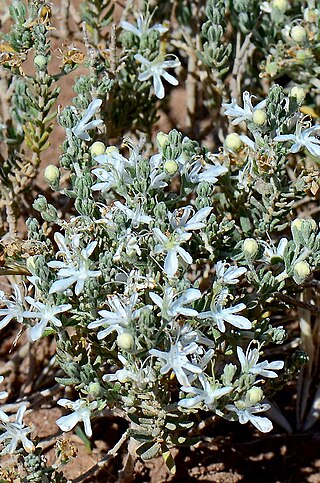
Teucrium albicaule, commonly known as scurfy germander, is a species of flowering plant in the family Lamiaceae, and is endemic to inland areas of Australia. It is a hoary, perennial herb that spreads by root suckers, forming dense stands. The leaves are trifoliate and the white flowers are arranged singly in leaf axils.

Westringia longifolia, commonly known as long-leaved westringia, is a flowering plant in the family Lamiaceae and is endemic to southeastern Australia. It is a small shrub, with linear leaves and mostly white flowers.

Westringia saxatilis is a species of plant in the mint family that is endemic to Australia.

Westringia davidii, also known as David's Westringia, is a species of plant in the mint family that is endemic to Australia.
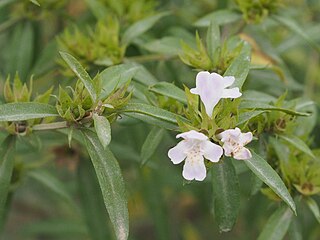
Westringia amabilis is a species of flowering plant in the family Lamiaceae and grows in New South Wales and Queensland. It is a small shrub with ovate-shaped leaves and light mauve to white flowers and brownish spots in the throat.

Westringia sericea, also known as native rosemary or silky rosemary, is a species of plant in the mint family that is endemic to Australia.

Westringia blakeana is a flowering plant in the family Lamiaceae and grows in New South Wales and Queensland. It is a small shrub with mauve to whitish flowers with brown spots and leaves arranged in whorls.
Westringia longepedunculata is a species of plant in the mint family that is endemic to Australia. It is found in south-eastern Queensland, and is sometimes considered to be a synonym of Westringia cheelii.

Westringia cheelii is a species of plant in the mint family that is endemic to Australia.

















